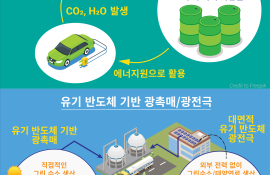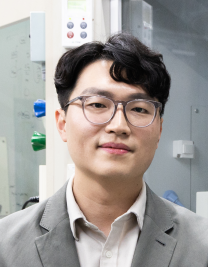- * 프린트는 Chrome에 최적화 되어있습니다. print

“Establishing the function of organic semiconductors as promising materials for solar-to-fuel energy conversion.”
Direct conversion of solar energy into solar fuels as a form of chemical energy at molecular level (e.g., solar H2 production) by photoelectrodes is a promising approach to reduce our dependence on fossil fuels and enable long-term energy storage. However, the identification of optimal semiconductors for large-scale photoelectrodes still remains a challenge. The vision of ONEL is to open a new era of solar fuel production using organic semiconductors which are highly promising due to their chemical tunability, solution-processability, and efficient light-harvesting ability.
Major research field
Synthesis of organic semiconductors, conjugated polymers, interfacial engineering, organic/inorganic junction, polymer processing
Desired field of research
Organic photoelectrodes, Tandem devices, Organic photocatalysts, Solar fuels, Artificial photosynthesis
Research Publications
•Nat. Catal. 2021, 4, 431−438, “A Semiconducting Polymer Bulk Heterojunction Photoanode for Solar Water Oxidation”, Han-Hee Cho, L. Yao, J.-H. Yum, Y. Liu, F. Boudoire, R. A. Wells, N. Guijarro, A. Sekar, and K. Sivula*
•Adv. Energy Mater. 2018, 8, 1701436, “Design of Cyanovinylene-Containing Polymer Acceptors with Large Dipole Moment Change for Efficient Charge Generation in High-Performance All-Polymer Solar Cells”, Han-Hee Cho, S. Kim, T. Kim, V. G. Sree, S.-H. Jin, F. S. Kim, and Bumjoon J. Kim*
•Energy Environ. Sci. 2021, 14, 3141−3151, “A hybrid bulk-heterojunction photoanode for direct solar-to-chemical conversion”, L. Yao†, Y. Liu†, Han-Hee Cho, M. Xia, A. Sekar, B. P. Darwich, R. A. Wells, J.-H. Yum, D. Ren, M. Grätzel, N. Guijarro, K. Sivula*
Patents
•신규한 나프탈렌다이이미드 기반 중합체 및 이를 포함하는 유기전자소자 (Novel naphthalene diimide based polymers and organic electronic device); 김범준, 조한희; 등록특허 10-1978556, 2019.05.08
•전자 도너-억셉터가 교차 반복 도입되는 공액 고분자, 이를 이용한 유기 광전자소자 및 유기 태양전지 (Conjugated polymer having electron donor and acceptor alternately, organic photoelectric device and organic solar cell comprising the same); 김범준, 조한희; 등록특허 10-1387065, 2014.04.14
국가과학기술표준분류
- EB. 재료
- EB03. 고분자재료
- EB0307. 에너지/환경산업용 소재기술
국가기술지도분류
- 환경/에너지 프론티어 진흥
- 031300. 에너지 소재기술
녹색기술분류
- 에너지원기술
- 수소/연료전지
- 243. 수소제조 및 수소저장 기타 기술
6T분류
- NT 분야
- 나노소재
- 030211. 나노소재기술 (나노분말소재, 광학용 나노소재, 고기능 시너지 소재, 촉매/환경/기능소재에 중점)




